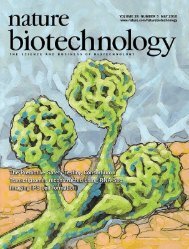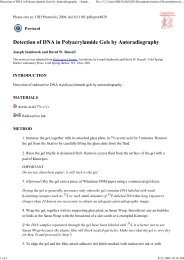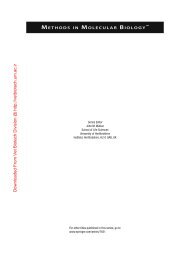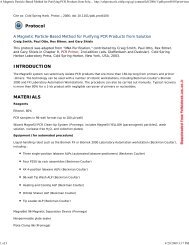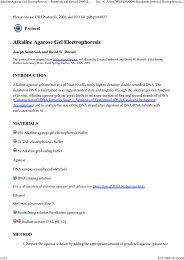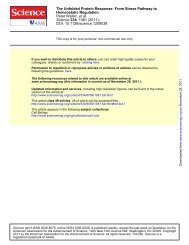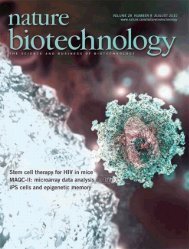Ontology engineering
Ontology engineering
Ontology engineering
You also want an ePaper? Increase the reach of your titles
YUMPU automatically turns print PDFs into web optimized ePapers that Google loves.
news© 2010 Nature America, Inc. All rights reserved.benefits of decreased insecticide use attributableto corn and cotton expressing genes thatencode one or more Bacillus thuringiensis (Bt)insect toxins. Bt crops could have a brighterfuture than herbicide-resistant transgenicvarieties, the report states, “but if, and onlyif, [insect] resistance is prevented.”The report is based on extrapolations ofpesticide use survey data compiled by theUS Department of Agriculture’s (USDA)National Agricultural Statistics Service(NASS). Benbrook relies on annual traitacreage data compiled by St. Louis–basedMonsanto to disaggregate transgenic cropsfrom the total crop acreage. However, noNASS data on corn or soy are available for2007 or 2008, years for which Benbrookposits unusually large pesticide increasesof 20% and 27%, respectively. The mainuncertainties stem from gaps in NASS data,which, since 2001, have only been gatheredintermittently, and from that data’s failure todistinguish between pesticide use on transgeniccrop varieties and on their conventionalcounterparts.Benbrook postulates the emergence of glyphosateresistance has fueled a sharp upswingin the use of other herbicides on glyphosatetolerantcrops, whereas levels of herbicide usedon conventional crops have fallen becauseof ongoing improvements in potency. ButJanet Carpenter, formerly of the Washington,DC–based US National Center for Food andAgricultural Policy and now an independentagricultural biotech consultant, disagrees.“That’s all extrapolation,” she says. “The bottomline is we don’t know what has happenedto pesticide use in the last couple of years.”Benbrook says that additional data fromfuture surveys can be factored into his modelwhen it becomes available. “The valid criticism—orvalid question—is these are allaverage numbers,” he says. “I would place afair amount of confidence in these averagesas a reflection of what’s going on out there.”In a published critique of the report,Dorchester, UK–based consultancy PGEconomics argues that Benbrook overestimatesherbicide application rates for biotechcrops and underestimates them for conventionalcrops (http://www.pgeconomics.co.uk/pdf/OCreportcritiqueNov2009.pdf). It citesa new study from the US Geological Survey,which found that concentrations of severalmajor pesticides either declined or remainedconstant in US corn belt rivers and streamsduring 1996–2006 (http://pubs.usgs.gov/sir/2009/5132/). However, the study perioddoes not include the two most recent years,during which Benbrook claims the greatestincrease in herbicide use has occurred. PGEconomics, which also published a lengthystudy on the global socioeconomic andenvironmental impacts of transgenic cropsin May last year, has drawn on two sources:pesticide use data from a commercial source,DMR Kynetec, of St. Louis, which Benbrooksays is in general agreement with his ownfindings; and what he describes as ‘faulty’simulation data generated by the WashingtonDC–based National Center for Food andAgricultural Policy, based on exercises runwith university extension weed scientists.“It’s impossible to reconcile their estimateswith the NASS data,” Benbrook says.In the meantime, several scientists havevoiced support for the general thrust of thestudy. “There’s nothing surprising there,”says Matt Liebman, who holds the H.A.Wallace chair for Sustainable Agriculture atIowa State University in Ames. Dealing withglyphosate-resistant weeds will require alterationsin cropping systems that rely solelyon the marriage of the herbicide-tolerancetrait and the associated herbicide to controlweeds. Widespread convergence on a narrowrange of options, such as the rotationof glyphosate-resistant corn and glyphosateresistantsoybean, has been a significant factor,says Liebman. “You have good conditionsfor rapid selection of herbicide resistance.”Monsanto and its competitors are respondingto the problem by offering farmers subsidiesto include third-party herbicides intheir weed control systems. They are alsostacking additional tolerance traits that canbe paired with other herbicides, such asdicamba (3,6-dichloro-2-methoxybenzoicacid), glufosinate (phosphinothricin) and2,4-d (dichlorophenoxyacetic acid). Externalfactors have hampered progress, however.“The biggest contributor to weed resistancehas been the European Union’s slow approvalprocess for new biotech-enhanced seeds.After many years of delays, the EU finallygranted approval of Liberty Link [phosphinothricin-acetyltransferase]soybeans, whichare resistant to a different active ingredient[l-phosphinothricin],” says Bob Callanan,communications director of the AmericanSoybean Association, located in St. Louis.Critics argue that more diversifiedapproaches will be needed, such as alternativecrop rotations, novel herbicides—it’s20 years since a new mechanism of actionwas commercialized, notes Boerboom—andalternative weed control methods. “If youwant to keep this tool available and effectivethere has to be some way, short of fallowinga field, of delaying the developmentof resistant weeds,” says Robert Kremer, ofthe USDA’s Agricultural Research Service atColumbia, Missouri. The market dominanceof transgenic crop varieties limits some ofthe options, however. “It’s very difficult togo and find nontransgenic soybean,” he says.“Conventional corn rotated with RoundupReady [glyphosate-resistant] soybeans wouldbe very logical,” says Boerboom. “We have anexcellent selection of conventional herbicideswe can use in corn.”That Monsanto’s Roundup Ready croppingsystem has been a major hit with farmersis not in dispute. “The simplicity, the highefficacy and the perceived low cost have beenvery attractive,” says Liebman. In this respect,even Benbrook agrees: “The weed managementsystems that Roundup Ready [crops]replaced were unforgiving and required ahigh level of skill and management to get thebenefits out of them,” he says. What’s more,glyphosate, which inhibits 5-enolpyruvylshikimicacid-3-phosphate synthase, a plantenzyme involved in amino acid biosynthesis(the engineered trait comprises a bacterialform of the enzyme, which is unaffected),has a relatively benign environmental profilein comparison with many other herbicides.Moreover, it has allowed many crop growersto shift to no-till agriculture, which reducesfossil fuel inputs.The problems farmers are encounteringnow are not new. “The selection forglyphosate resistance is not unique. We’veselected for a whole lot of other herbicidefamilies as well,” says Aaron Hager, weedscience extension specialist at the Universityof Illinois at Urbana-Champaign, Illinois.“There’s a plant somewhere in the worldthat’s resistant to an herbicide that hasn’teven been discovered yet. That’s how selectionoccurs.”As glyphosate has played a central role inUS crop production over the past decade, itcan be argued the technology has become avictim of its own success. For many farmers,weed control will, however, soon becomemore complex. Some of the alternativesoffer less favorable environmental profiles.Dicamba, a synthetic auxin or plant hormone,can drift off-site and interfere withflowering plants, for example. “There will beobjections raised to it by the environmentalcommunity because of nontarget effects,”says Liebman.Nevertheless, US agriculture is not facing adoomsday scenario, according to Boerboom.“I don’t think it’s like we’re going into somedark age of chemical use on the landscape,”he says. But a new phase in the moleculararms race between biotech and nature is gettingunderway.Cormac Sheridan Dublinnature biotechnology volume 28 number 2 february 2010 113




